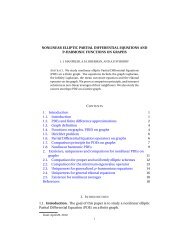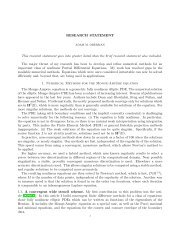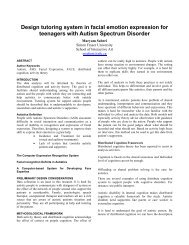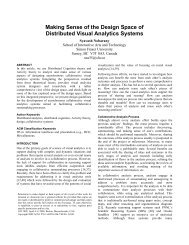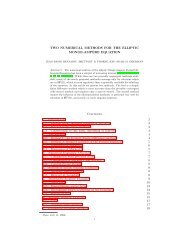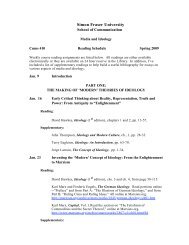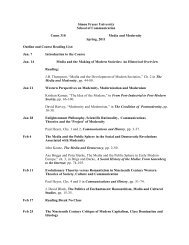Boyd Convex Optimization book - SFU Wiki
Boyd Convex Optimization book - SFU Wiki
Boyd Convex Optimization book - SFU Wiki
You also want an ePaper? Increase the reach of your titles
YUMPU automatically turns print PDFs into web optimized ePapers that Google loves.
300 6 Approximation and fitting<br />
PSfrag replacements 20<br />
10<br />
f(t)<br />
0<br />
−10<br />
−20<br />
−10 −5 0 5 10<br />
t<br />
Figure 6.5 The 42 circles show points that can be well approximated by<br />
an affine function, except for the two outliers at upper left and lower right.<br />
The dashed line is the least-squares fit of a straight line f(t) = α + βt<br />
to the points, and is rotated away from the main locus of points, toward<br />
the outliers. The solid line shows the robust least-squares fit, obtained by<br />
minimizing Huber’s penalty function with M = 1. This gives a far better fit<br />
to the non-outlier data.<br />
with variables α and β. The least-squares approximation is clearly rotated away from<br />
the main locus of the points, toward the two outliers.<br />
The solid line shows the robust least-squares approximation, obtained by minimizing<br />
the Huber penalty function<br />
∑ 42<br />
minimize φ i=1 hub(y i − α − βt i),<br />
with M = 1. This approximation is far less affected by the outliers.<br />
Since l 1 -norm approximation is among the (convex) penalty function approximation<br />
methods that are most robust to outliers, l 1 -norm approximation is sometimes<br />
called robust estimation or robust regression. The robustness property of<br />
l 1 -norm estimation can also be understood in a statistical framework; see page 353.<br />
Small residuals and l 1 -norm approximation<br />
We can also focus on small residuals. Least-squares approximation puts very small<br />
weight on small residuals, since φ(u) = u 2 is very small when u is small. Penalty<br />
functions such as the deadzone-linear penalty function put zero weight on small<br />
residuals. For penalty functions that are very small for small residuals, we expect<br />
the optimal residuals to be small, but not very small. Roughly speaking, there is<br />
little or no incentive to drive small residuals smaller.<br />
In contrast, penalty functions that put relatively large weight on small residuals,<br />
such as φ(u) = |u|, corresponding to l 1 -norm approximation, tend to produce



